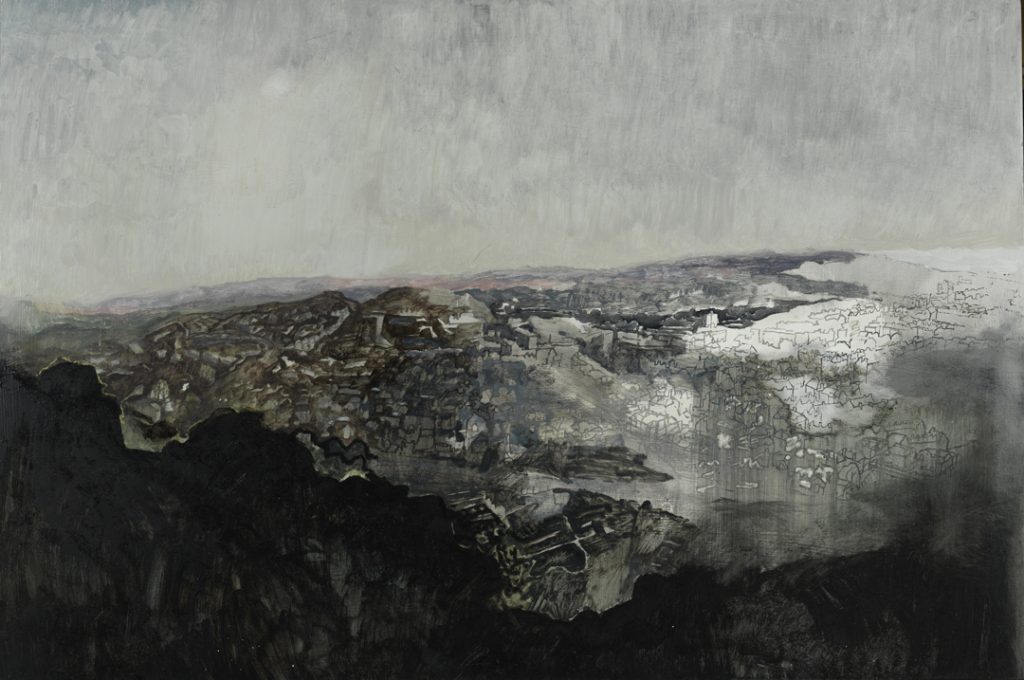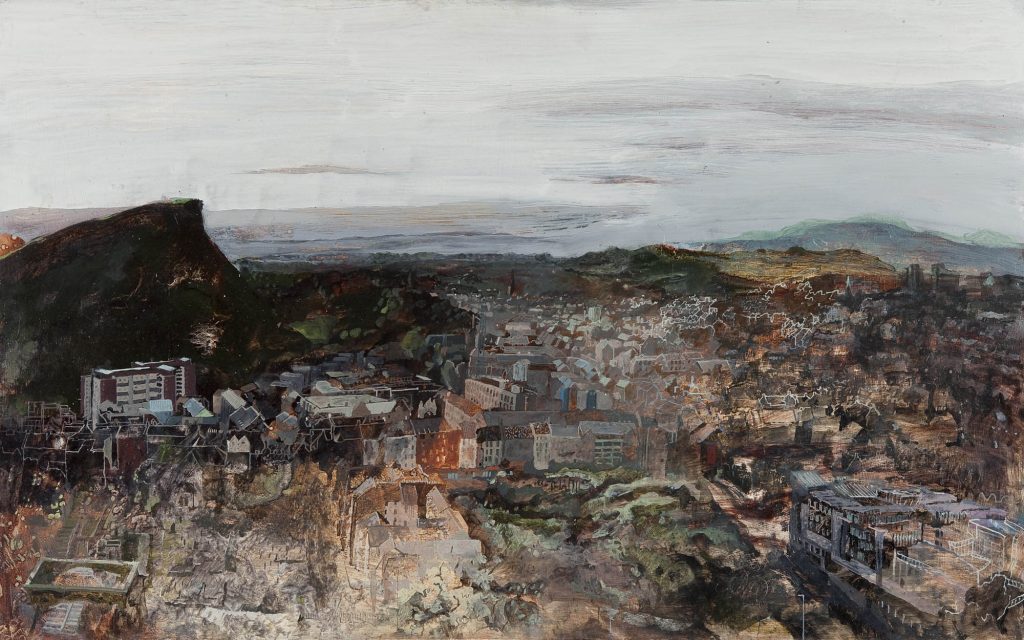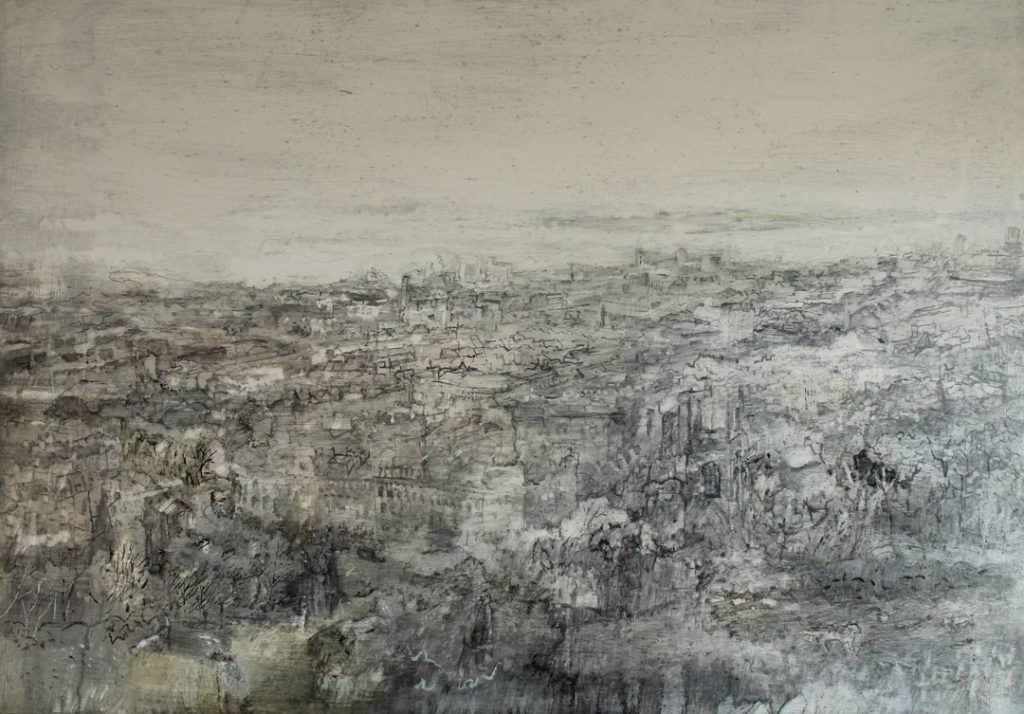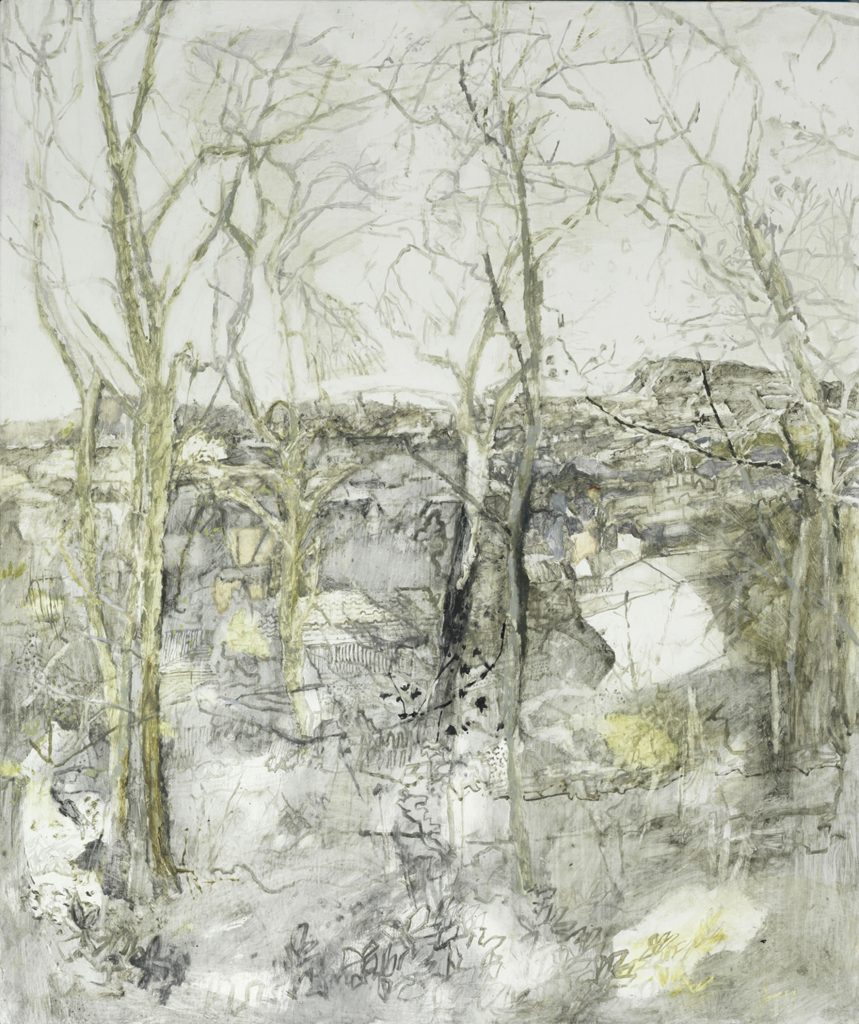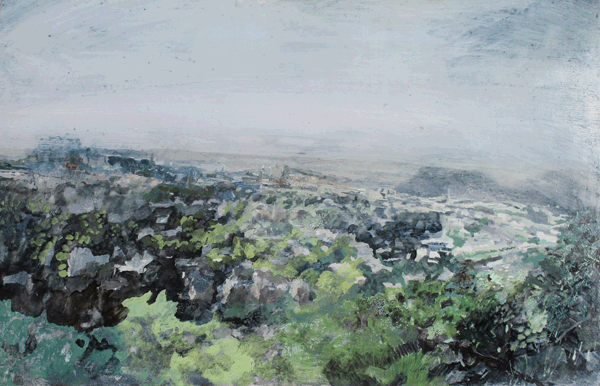Catharine Davison Painter - Edinburgh, Scotland
Can you discuss how place influences your work? (Take two pieces to show this.)
I remember being visually aware as a child, growing up in Kilkeel in Northern Ireland, a market town with an impressive fishing port and the Mountains of Mourne as backdrop. As a family we enjoyed the outdoors and so from an early age began connecting with the ‘landscape’. The process of seeing, editing and then recording has always been my way of connecting with the world around me. I moved to Edinburgh, from the South of England in 2007 and feel very at home in this city built around seven hills.
My relationship with Edinburgh could be described as being identifiable through my work from Blackford Hill, Calton Hill and from Holyrood Park. Morning Dusk, (from Blackford Hill), 80 x 120 cm was painted during the winter months in 2015. The title refers to the eclipse and although this was a moment in passing it gave me a way in to connect with this particularly challenging view. I have drawn and painted this aspect of the city many times, this is part of my process
Morning Dusk (from Backford), 80 x 120 cm
I began this work by drawing, using oil thinned with turpentine, the architectural arrangement of the domestic homes as they sit on the hill. Working as usual on location, returning over 5 days I slowly pieced together the lines, like a jigsaw that would form the structure of the work.
The appearance of the city is never fixed- changing under different light and weather conditions and so there is a sense of transience. This quality is well reflected in another painting from Blackford Hill, ‘The City’, 80 x 100. Undoubtedly Edinburgh with the Salisbury Craggs brooding on the horizon, the black glaze continues across engulfing the heart of the City. While I am processing the immediate visual references directly in front of me I am also thinking about other conversations. This state of flux interests me.
Expand on the landscape and human intervention (architecture) in your work.
For me the urban landscape is subject through which I can explore ideas about time, both time passing and the times we are living in, economies, and through the architecture and development there is a sense of permanence but fragility.
Discuss the importance of winning the Lynn Painter-Stainers Prize was to your career?
About the award generally.
For me to have been awarded the Lynn Painter- Stainers Prize for creative representational painting in 2014 for my painting ‘The Craggs at Dawn, (from Calton Hill) 80 x 120 cm, was a wonderful affirmation of my work. Looking back it was definitely a milestone. I was able to make decisions about how I would use the time ahead of me effectively. It is amazing how much emotional energy is attached with financial concerns. As well I have always been involved with art education and although this is incredibly rewarding, I am not the sort of person who takes responsibility lightly and so with the award I was able to make the decision to do less teaching. The exposure was enjoyable and I have been invited to be more involved in projects. However in the months leading up to my second solo exhibition at The Open Eye Gallery. I felt a weight of expectation and this was a feeling I had never experienced before. The art industry is so competitive. Fortunately as I immersed myself in the body of work I became so involved and committed to producing work with integrity and this gave me the confidence in the exhibition.
The work that won you this prize
‘The Craggs at Dawn, (from Calton Hill) 80 x 120 cm
The Craggs at Dawn, (from Calton Hill) is a painting depicting the city of Edinburgh as it occupies the space between Salisbury Craggs and The Castle. It is an iconic view- one that visitors will admire in awe of the spectacle. The ‘Old Town’ is very visible with the contrasting modern domestic architecture on the fringes. I knew the location would be busy with tourists and so if I wanted to make this work I had to commit to getting up early before the bus tours got there. There was an under painting of warm tones on the board and so on my first sitting I painted the broad sweep of the blue/grey sky- identifying the horizon and The Craggs. It took several sittings building layers of glazes and sections of finely drawn architecture. The City Art Gallery in Edinburgh now owns the painting.
Discuss two of the works you had exhibited at the Open Eye Gallery in 2015?
Beyond Land, (from Calton Hill), 78 x 110 cm
This is one of my favourite locations and views over the city. I have made many drawings and several smaller paintings. I wanted to reflect the feeling of being immersed and consumed by the landscape.
I began this work in the studio by projecting a very detailed line drawing so that I had the framework for the painting in place. Then working from Calton Hill I used thin layers of monochromatic paint, pushing and pulling the architectural mesh- both together then apart. Limited tonal palette was used to emphasise the surface quality rather than topographical detail.
Chasing Shadows, (Blackford Hill View) 76 x 63 cm
Reflecting on how the domestic home and urban landscape is represented for dramatic purposes on screen and for tv. I enjoy Michael Raedeckers’ stitched works on canvas- they are both minimal but intriguing. His use of line and composition are very deliberate and was thinking about his work at this time.
I worked immediately on the white surface of the primed board using very little medium to thin the oil paint. I wanted to explore how paint can be pushed and moved around to form lines and marks.
This is a portrait format, lending itself to the height of the trees. I wanted to use the trees to enhance the feeling of mystery and also as a compositional device to add space. There are parts where I have wiped back to suggest a momentary distraction…interrupted focus.
Limited tonal palette was used to emphasise the surface quality rather than topographical detail. I will often introduce a new colour or series of colours into my palette and during this period of work I was using Davy’s grey, Olive green and Lamp Black.
In your quote above, “Working from direct observation on location is at the heart of my practice” Catharine Davison. Can you explain how you work from location, do you use photography, sketch books or plein air?
Carving out time to think is my first action, then I go walking. I take a sketchbook for note making and drawing. The notes will be a record of things I see and hear. I might be listening to the radio, reading or pick up on conversation and find words forming connections to images. Together giving me ideas of how to approach a subject or titles for my work. The initial phase in any new project can be quite fragile, I like to be able to immerse myself in a contemplative space. The making is quite a different energy. I think I relax more when the actual making is underway.
Discuss your use of lime and soft glazes to capture that misty Scottish environment.
I remember when I was studying for my degree at Liverpool John Moores’ University that I became aware of an instinctive approach to recording the world around me. Working with dip pen and ink I was inspired by the mark making in works by artists Anthony Gross, John Piper and Van Gogh. Since I have always made drawings with a keen and playful exploration of line and mark, developing and growing a personal vocabulary. The soft glazes are not a conscientious response to misty weather. I developed this approach to working with thin layers of paint, oil or watercolour in response to practical need, wanting to work at pace on location and with layers, and also to suggest transience and a sense of flux- thinking about the ideas of focus that I have mentioned.
You use colour very minimally discuss?
I have learned not adhere to local colour- instead bringing colour references to the painting. I collect colour sources from magazines, TV drama stills – in particular from the new wave of Nordic Noir, or naturally occurring colour combinations such as a delicate pastel green lichen on powder grey stone. Colour for me is about suggesting a mood rather than describing topographically what is there.
Many of your paintings are taken from the vantage point of looking down, discuss?
From the hill top vantage points you get a real sense of the city. This connects with my on going exploration of ideas- using the city as a platform for my work. That aside, Its amazing what you can hear – football crowds singing or cheering in the distance or people working in the allotments below or a siren.
Heat of the Land (from Blackford Hill) 60 x 90 cms
Discuss how you are able to show climate in your work.
I am not conscientiously interested in depicting climate. However, the light, weather conditions and time of year undoubtedly affect the appearance of the landscape. The painting has to work as a whole- so I am controlling the painting rather than letting the light control govern my responses. I do watch the weather forecast avidly and plan my week ahead accordingly.
It was 2006 and 2007 you worked in Cyprus, can you say something about the experience and the work you made while you were there.
In 2006 I made a series of watercolour paintings in response to the rural landscape. The richly patterned organisation of hills gave me the opportunity to develop a corresponding tapestry of marks in watercolour. In 2007, I was artist in residence for three months at Cyprus College of Art (which had just opened a new centre in Larnaca) overseeing the summer programme. I quickly established good relationships between the local residential community and the student artists at the college, enabling an exhibition of student work at the local ‘Gallery Kypriaki Gonia’ – with the Mayor as guest of honour. This mutual respect aided my own practice towards a visual investigation of the lives and homes of the people I met. Learning just enough Greek to communicate with my new neighbours to share food and stories about their lives; many the product of political displacement. I drew and painted their homes, gardens and backyards – bringing valuable insight and life to a series of urban garden works.
Your paintings are showing Edinburgh from so many different vantage points are you ever asked to paint a specific aspect?
I am not interested in taking commissions and although I have been approached by individuals asking if I will- we never get as far as discussing where they have in mind.
Discuss your thoughts on the importance of capturing the City of Edinburgh or is it you as an artist wanting to share the city you love?
I don’t really think about ‘Edinburgh’ as a specific place in my work. I set out to make searching drawings and paintings that go beyond the topography. However when I show my work then it no longer belongs to just me- I can’t tell people what they need to see or feel when they look at one of my works.
I see you have been running courses at Edinburgh University, both in the Department of Life Long Learning and also at the College of Art where you have run some courses in the Department of Illustration. Can you tell us a bit about your teaching?
Over the past year I have been running the Portfolio Preparation Course for Art and Design Studies. This course is designed to give students a platform to explore their own ideas through individual development. Each week the 2 and ¾ hour session would provide students with a prompt- conceptually or through materials and processes. Drawing and painting from observation as a set task was integrated into the initial sessions, for instance for the first week all students made a painting working from crumpled paper, a project inspired by artist Louise Hopkins, and there was also a session drawing from a life model. Exhibitions at the Royal Scottish Academy gave students the opportunity to interrogate and respond to a wide range of other contemporary artists work. In the studio the students explore materials and processes, using everyday materials such as cardboard to make a sculpture and mono printing was used to method to develop ideas. I encouraged students to make a record of their work each week by taking photographs and making a presentation in a sketchbook format. Every session was followed with suggestions for independent study at home.
What advice to you give your students to keep them encouraged about their work?
I approach teaching from the point of view that there should be a connection with the human and the artist. I suppose I set about to identify the characteristics and the personality behind the work and this will help find inspiration and help me communicate to the individual. The art has got to come from the student- they need to want to make the work. I see myself as a facilitator. I think you need to be patient and resilient to make work on location. It can be very rewarding, exciting but demoralising and challenging.
How important were Tutors to you during your time at Art School and what advice were you given that still helps you today?
It was my Drawing tutor at Liverpool John Moores University, Julia Midgely who encouraged me to develop my drawing skills working on location. I remember finding the projects difficult- I studied Illustration, and when I found a way in through drawing, the tutors were supportive and encouraged me to keep doing the work I needed to do. On my Masters Degree at Buckinghamshire Chilterns University the tutors were fantastic. John Richardson was the Head of Faculty and it was through his contacts and hard work that I received funding from Allied Domecq Wines and Spirits. For my major project I travelled to the Laphroaig Whisky Distillery on Islay in Scotland where I made a visual record of the working life. The Etching Tutor Elizabeth Butterworth had a great work ethic and pushed to make use of every moment of contact we had and I remember artist and tutor Tom Hammick- advice to ‘use best materials you can afford’. I hear myself passing on the wisdom and learning to students. Being an artist is a way of living.
How important is contact with other tutors to you and your work?
It is an essential support mechanism. A lot of the professional artists I know work in art education in some way or other. In the same way my tutors at college would share nuggets of wisdom, I might pick up some good advice that will guide or inspire me; for example at the recent opening event to celebrate the Edinburgh Arts Festival I was talking to an artist friend, Jenny Smith who suggested I look up John Cage and sister Corita Kent list of advise for students, teachers and life and from this I read ‘Don’t try to create and analyze at the same time. They’re different processes’.
One of the most frequented conversations is the balance of work- work we need to do to live and work we want to do. My partner, Robbie Bushe is also an artist and I like that that we able to give each other the space and time to do the work we need to do – when we need to do it.
Contact details.
Catharine Davison, Edinburgh, Scotland
Interview by Deborah Blakeley, September, 2015
Think a colleague or friend could benefit from this interview?
Knowledge is one of the biggest assets in any business. So why not forward this on to your friends and colleagues so they too can start taking advantage of the insightful information the artist has given?
Other artists you may be interested in:



